Click on images to enlarge
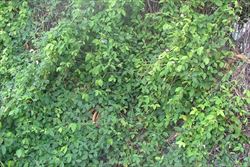
infestation (Photo: Sheldon Navie)

climbing habit (Photo: Chris Gardiner)

creeping habit (Photo: Sheldon Navie)
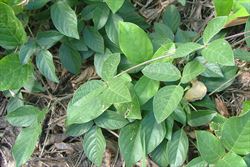
leaves (Photo: Sheldon Navie)
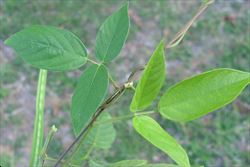
slender twining stems and compound leaves with three leaflets (Photo: Sheldon Navie)
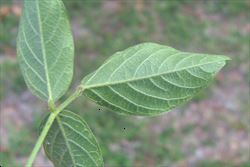
close-up of leaflet undersides (Photo: Sheldon Navie)

pea-shaped flowers (Photo: Sheldon Navie)

close-up of flower (Photo: Sheldon Navie)
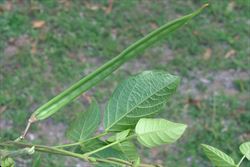
immature fruit (Photo: Sheldon Navie)
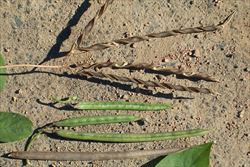
immature, mature and old fruit (Photo: Chris Gardiner)

the very similar Centrosema pubescens, with broader leaflets (Photo: Chris Gardiner)

the less similar Centrosema pascuorum, with much narrower leaflets (Photo: Chris Gardiner)
Scientific Name
Centrosema molle Mart. ex Benth.
Synonyms
Centrosema pubescens Benth. (misapplied)
Family
Fabaceae (Queensland, the ACT, Victoria, Tasmania and the Northern Territory)Fabaceae: sub-family Faboideae (New South Wales)Leguminosae (South Australia)Papilionaceae (Western Australia)
Common Names
bluebell, butterfly pea, butterfly-pea, centro, common centro, spurred butterfly-pea
Origin
Native to Mexico, Central America (i.e. Costa Rica, El Salvador, Guatemala, Honduras, Nicaragua and Panama) the Caribbean and tropical South America (i.e. Venezuela, Brazil, Bolivia, Colombia, Ecuador and Peru).
Naturalised Distribution
Naturalised in northern and central Queensland, in the northern parts of the Northern Territory and on Christmas Island. It has also been recorded from disturbed sites around Kununurra in northern Western Australia.
Naturalised overseas in Indonesia, Hawaii and on several other Pacific islands.
Notes
This species was introduced as a pasture legume, but is now regarded as an environmental weed in the tropical regions of northern Queensland and the Northern Territory. It is actively managed by community groups in the Northern Territory and is listed as an "undesirable plant" in the Wet Tropics World Heritage Area of northern Queensland.
Common centro (Centrosema molle) is a vigorous creeper or climber that invades disturbed forests and chokes out more desirable species. The tree layer of forests can even be destroyed, and the regeneration of native species prevented, by dense infestations.
Several other similar Centrosema species are cultivated as pasture legumes in northern Australia, some of which have also become naturalised.
Note: Until recently, common centro (Centrosema molle) has largely been known by the scientific name Centrosema pubescens in Australia. However, it is now believed that the name Centrosema pubescens should be applied to a different plant previously known as Centrosema schiedeanum.

